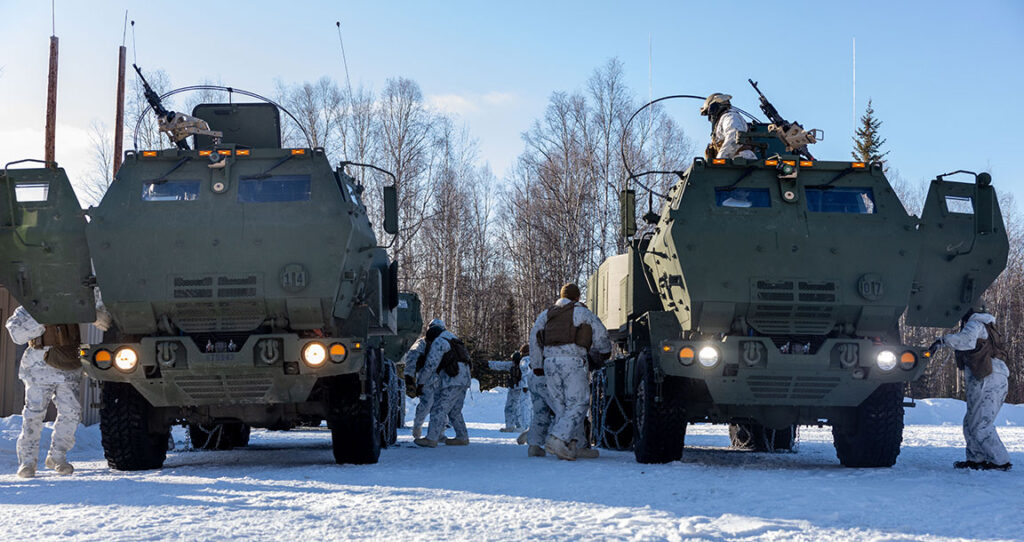U.S. Marines with Fox Battery, 2nd Battalion, 14th Marine Regiment, 4th Marine Division, Marine Forces Reserve ready High Mobility Artillery Rocket Systems for live-fire engagement as part of Arctic Edge 2024 at Eielson Air Force, Alaska. LANCE CPL. MADISYN PASCHAL/U.S. MARINE CORPS
THE WATCH STAFF
U.S. Marines showcased their ability to operate the High Mobility Artillery Rocket System (HIMARS) in harsh Arctic conditions during a recent exercise in Alaska. The HIMARS Rapid Infiltration exercise, known as HIRAIN, demonstrates the ability of U.S. forces to rapidly deploy the latest military technology in any conditions to defend the homeland.
As part of the larger Arctic Edge 24 exercise, Marines on February 24, 2024, conducted HIMARS operations in windy, snowy conditions at Eielson Air Force Base, about 23 miles south of Fairbanks in central Alaska. Marines with Fox Battery, 2nd Battalion, 14th Marine Regiment, 4th Marine Division, Marine Forces Reserve fired rockets from the battery, which can fire six rockets simultaneously with a range of up to 100 miles.
“With the adversaries we are facing now, this training is crucial due to the environmental challenges we anticipate,” said Sgt. Ronald Merritt, a HIMARS operator with Fox Battery. “Our focus is protecting our homeland and addressing any potential threats that may arise in close proximity to our homeland,” according to a Marine Corps news release.
Arctic Edge 2024 presented Fox Battery with the opportunity to conduct a HIRAIN in extreme Arctic weather for the first time. A HIRAIN involves the rapid unloading, reloading and relocation of HIMARS to reduce the risk of detection and counterattack. “This training goes to show that a Marine can operate in any climate, any place. Whether it be a dry desert, a jungle environment, or a cold arctic climate,” said Gunnery Sgt. Jon Ohlman, Fox Battery, 2nd Battalion, 14th Marine Regiment. At one point, the temperature plummeted to -68 degrees Fahrenheit. Given that the freezing point of hydraulic fluid is -10 degrees, the Marines had to conduct a “warm-up” by running hydraulic fluid through the systems to keep them in good operating condition. “We learned a lot right off the bat,” said Capt. Colton Raab, Field Artillery Officer with Fox Battery. “We had enough support from both the Army and our battalion regiment that we adjusted extremely fast and were able to perform.”
HIMARS has been an increasingly high-profile weapons system in light of the U.S. decision to arm Ukraine with it after Russia invaded in 2022. First developed by Lockheed Martin in 1996, the Marine Corps began integrating the system into training exercises in 2005. In 2007, Fox Battery was the first unit to use HIMARS in combat. “We can be rapidly deployed to forward positions, allowing us to process missions much faster than traditional artillery,” said Ohlman, a HIMARS operator with Fox Battery. “Our capability for long-range precision fires, coupled with our mobility using C-130 and C-17 transport, enables us to be swiftly positioned in areas of the battlespace that would otherwise be out of reach for conventional weapon systems,” he said.
Arctic Edge 2024 (AE24) is a U.S. Northern Command-led homeland defense exercise that demonstrates the U.S. military’s capabilities in extreme cold weather, joint force readiness and U.S. military commitment to mutual strategic security interests in the Arctic region. HIMARS is a vital part of the Marine Air-Ground Task Force (MAGTF), providing precision fire support, maintaining long-range communication and adding to the force’s versatility and effectiveness, according to the release. “HIMARS have become more public, showing its accuracy and capabilities,” said Master Sgt. Gerald Wendel, Artillery Unit Leader with Fox Battery. “Other units such as the Special Operations Force (SOF) are realizing how much of an asset HIMARS is and how precise it is.”
The Marines also operated in tandem with several other U.S. military units including the Marine Aerial Refueler Transport Squadron (VMGR) 234, Marine Aircraft Group 41, 4th Marine Aircraft Wing, Marine Forces Reserve, Marine Air Control Squadron 24 (MACS-24), Marine Air Control Group 48, 4th Marine Aircraft Wing, Marine Forces Reserve and the Army unit, Apex Battery, 17th Field Artillery Battalion (FAB). “Working alongside the FAB, we taught each other tips and tricks and bounced new ideas off one another,” Merritt said in the release. “While conducting onloading and offloading drills for the C-130s, both launcher crews employed different methods, and this became a significant learning experience.”

